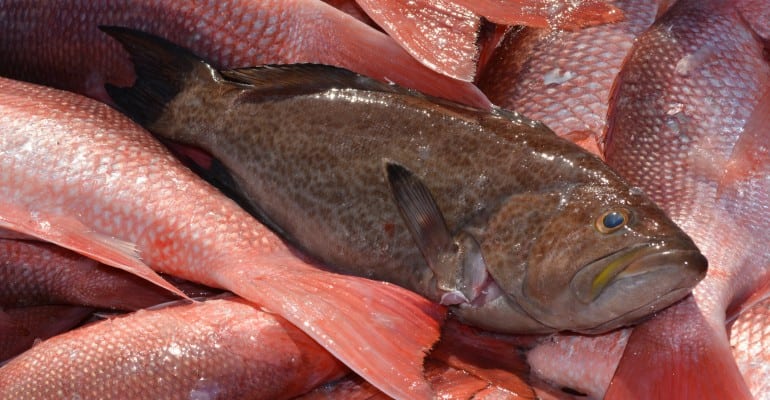The Gulf of Mexico Fishery Management Council met virtually on October 26-28, 2020. The Council began by populating its Council Committee Roster for October 2020 – August 2021. The meeting agenda was modified to allow Council members, fishermen, and the broader stakeholder community time to prepare for the anticipated landfall of Hurricane Zeta.
The following is a brief overview of what was accomplished during the meeting:
Executive Order: Promoting American Seafood Competitiveness and Economic Growth
The President of the United States recently signed an Executive Order on Promoting American Seafood Competitiveness and Economic Growth. The Executive Order aims to improve the competitiveness of our domestic seafood industry, put more Americans to work, and place more sustainably sourced and safe-to-eat seafood products on our families’ tables. Section 4 of the Executive Order, Removing Barriers to American Fishing, requires the Regional Fishery Management Councils to submit a prioritized list of recommended actions to reduce burdens on domestic fishing and to increase production within sustainable fisheries. At this meeting, the Council finalized its list of recommendations and gave each one a priority ranking.
Illegal Charter Activity in Federal Waters
The Council will draft a letter asking NOAA to increase efforts of the Joint Enforcement Agreement between state and federal law enforcement agencies to deter illegal charters from operating in federal waters. The Council will also suggest that NOAA establish a new intelligence gathering program that will work will federal permit holders to identify suspect vessels and share that information with state law enforcement partners.
Budget
The Council reviewed its budget and expenditures for the 2015-2019 administrative award and decided to request a second no-cost extension to complete work that was originally scheduled in the previous award to be carried over an additional 1-year due to impacts of COVID-19 on travel and meetings. The scope of work has been modified and will be submitted to NOAA Grants Management Division for review and approval. The Council also requested more information on the potential for using unspent 2020 funds to consider funding an independent offshore purse seine study of red drum and for an independent stock assessment on gray triggerfish.
Recreational Red Snapper State Catch Limits
The Council took its first look at a draft framework action that considers adjusting individual state private recreational red snapper catch limits. NOAA Fisheries has been using the federal Marine Recreational Information Program (MRIP) in concert with landings and effort data collected from Gulf state data collection programs to monitor private recreational red snapper seasons. The Council discussed incorporation of the Great Red Snapper Count into an interim analysis for red snapper that may be available in the spring and noted that red snapper catch limits are expected to increase; however, increasing the catch limits doesn’t address the differences in the data reported by each state survey. Adjustments to the state-specific catch limits are also being considered to account for the harvest monitoring programs used by each state. The Council intends to discuss the differences in state data currency once the red snapper interim analysis is completed.
Red Grouper
The Council continued working on Reef Fish Amendment 53, which considers modifying red grouper commercial and recreational sector allocations and catch limits based on the results of the latest stock assessment (SEDAR 61). The assessment showed that the red grouper stock size is smaller than it has ever been. Additionally, the assessment used the new Marine Recreational Information Program Fishing Effort Survey (MRIP-FES) landings and effort estimates, which has increased the estimates of recreational harvest. The Council expressed concern with differences between landings used in the stock assessment and landings used for annual catch limit monitoring. The Council decided to ask its Scientific and Statistical Committed to further explore those differences. Since the Council did not select preferred alternatives in Amendment 53 this could inhibit the Regional Administrator from withholding the distribution of allocation to individual fishing quota program participants in the commercial sector at the beginning of 2021.
Gray Triggerfish
The Council was presented with a summary of an interim analysis of the gray triggerfish stock that uses video surveys to estimate abundance. The analysis shows that the gray triggerfish stock has been increasing, especially in the eastern Gulf, and that catch limits can be increased. The Council’s Scientific and Statistical Committee recommended increasing the gray triggerfish acceptable biological catch limit to 456,900 pounds whole weight. The current gray triggerfish annual catch limit is 305,300 pounds whole weight; thus, the Council initiated work on an action to increase the gray triggerfish catch limit and will also consider removing the January and February recreational closed season.
King Mackerel
The Council was presented with results of an update stock assessment for king mackerel. The update assessment determined that king mackerel is not overfished and is not experiencing overfishing. The king mackerel stock size is above the minimum stock size threshold but below the stock size necessary to produce maximum sustainable yield. The Council also heard a summary of public input on the health of the stock that it received through its Something’s Fishy with King Mackerel tool. Those comments indicated a negative trend in stock abundance, especially in the northern Gulf. The Council’s Scientific and Statistical Committee recommended increasing acceptable biological catch limits for 2021-2023. These updated limits account for the slight decline in stock biomass, and use the new Marine Recreational Information Program Fishing Effort Survey (MRIP-FES) landings, which increased the overall estimate of abundance. The Council decided to initiate development of a plan amendment to adjust current king mackerel catch limits and consider modifying sector allocations.





